 B. Satish Kumar,
B. Satish Kumar,
Managing Director,
Steel Exchange India Ltd
Steel Exchange India Ltd, a leading manufacturer and trader of steel products based in Visakhapatnam, Andhra Pradesh, is currently executing several projects in both steel and power industries. These include sponge iron and iron ore pellet plants, and a 100-MW power plant. B. Satish Kumar, in an email interaction with Prashant C. Trikannad, talks about the current and future scenarios in the Indian steel industry.
Can you provide a brief overview of the Indian steel industry in 2013-14?
Steel production is expected to register a growth of about 2-4 per cent in 2013-14 to about 90 millions tonnes. Going forward, the growth rate is expected to improve to about 5 per cent in the next five years.
Infrastructure is the single most crucial and critical consumer of domestic steel production. Any slowdown in this sector has direct impact on steel sector. Last four years have seen a lot of pressure on the margins even for the integrated steel players with captive mines as the end prices are still low compared to the input costs which form a major chunk of costs.
Demand has been sluggish with barely 2-4 per cent growth.
What kind of impact did infrastructure projects have on steel in 2013?
Due to economic slowdown and environment clearances, many planned infrastructure projects have not yet started while the existing projects have become sluggish. Being a large consumer of steel, it is having a direct impact on the steel production and margins.
Moreover, this also has regional impact on the steel units as per their location.
What are your expectations for this sector in the next fiscal?
The demand and prices are expected to improve from 2014-15 onwards.
Can you highlight the key challenges and opportunities in the steel industry?
The economic slowdown has adversely affected many small and medium units with many having to shut down. The margins of integrated steel units are also affected. Being capital intensive, servicing of interest and loans get affected and these are some of the critical challenges steel units have to face during the slowdown.
But with many small and medium units being shut down, most of the large integrated manufacturers have registered anything between 10 per cent to 20 per cent growth in their production capacities.
Which are some of the main drivers, or sectors, for the growth of the steel industry?
Infrastructure, automobiles and consumer durables are the main drivers for growth of steel industry.
Based on demand projections, crude steel capacity is expected to grow from 90 million tonnes in 2011-12 to 140 million tonnes during the 12th Plan. Do you agree with this assessment?
With the recent slowdown this may be an ambitious target but not formidable. Many new units that were to come up are delayed for various reasons like land acquisition, environment clearances, high interest costs and the economic slowdown.
Government populist policies and subsidies need to be carefully balanced with infrastructure expenditure and not at the cost of it, if India is to have sustained development.
Can you discuss SEIL’s current operations vis-à-vis manufacturing plants and their capacities as well as expansion plans?
SEIL’s current operations are at about 65 per cent capacity utilisation which is mainly for certain internal factors. The company has a history of turning around sick units. These were completed by 2013 and we expect 2014-15 onwards to be able to achieve 80 per cent and above capacity utilisation.
What is the status of your ongoing projects in both the steel and power sectors?
The projects of steel were completed by 2011. The 66-MW captive power plant set up by an SPV promoted by SEIL was completed in 2013. The power unit is functioning smoothly and has clocked above 85 per cent PLF.











